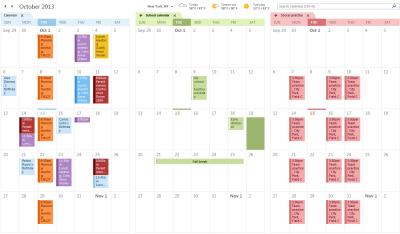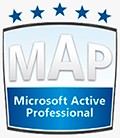

Today we´ll see how to hide a user from the Global Address List (GAL from now on) in Office365 with the user of Poershell.
We all know that it´s possible to hide a Distribution Group or a Security Group from the GAL, but that option is not available for new and existing mailboxes and users via GUI (Graphical User Interface), but it´s possibe with the user of Powershell. So lets see how to do it:

The first thing will be to prepare our environment if we already don´t have it to connect with Microsoft Online Services.
Then we must log on to our Office365 subscription with admin credentials using powershell, and run the following command:
Set-Mailbox -Identity user@contoso.com -HiddenFromAddressListsEnabled $true
Once it finishes, the user will be hidden from the GAL :)
Fast and easy! until next post.
Me gusta:
Me gusta Cargando...


Before beginning this post, i must say that this is only possible via powershell, so we must have our environment ready for office365, if you don´t have it, click here to get it done..
If you alredy have the envornment ready for it, then proceed with the following code:
- $LiveCred = Get-Credential (Get credentials to log on our office365 subscription)
- $Session = New-PSSession -ConfigurationName Microsoft.Exchange -ConnectionUri https://ps.outlook.com/powershell/ -Credential $LiveCred -Authentication Basic -AllowRedirection (configure the type of session)
- Import-PSSession $Session (import the session from the server)
- Connect-MsolService (connect to Online services and input one more time our admin credentials)
- Get-MsolUser -UserPrincipalName user@contoso.com | Set-MsolUser -PasswordNeverExpires $true (specify that the user user@contoso.com to never expire his password)
If we want to apply for all users created, then run the following commands:
- Get-MsolUser | Set-MsolUser -PasswordNeverExpires $true
- Get-MsolUser | Select UserPrincipalName, PasswordNeverExpires
Hope it helps someone.
Me gusta:
Me gusta Cargando...

On this post, i´ll explain how to configure a disclaimer on our Exchange Online subscription.
Even though you can configure it as part of the signature in our Outlook, this tutorial is specially good for companies with many pcs and users on one or more sites.
It´s good to say that this procedure covers all that an outlook signature can´t, i.e, mobile devices like BlackBerry, Android, Windows Phone, IPhone, etc… that have the Exchange account configured, when sending e-mails, automatically append the disclaimer, and don´t write it every time we configure each one of our devices (including OWA).
It´s precise to remark before you continue reading this article, that the options we´ll be using, will only be available on E1, E2, E3, E4 and Exchange Online Plan 1 subscriptions. If we have an Office365 P1, we wont have those options available because that feature is not available on small and mid-sized company plans.
Once cleared this off, lets proceed creating our disclaimer on our Office365 environment.
- First of all, access the administration portal http://portal.microsoftonline.com , using the admin credentials.
- Once inside, go to «Manage» just under «Exchange» on the center area.
- It will open the Exchange Administration console of our company, then click where it says «Mail Control«
-
Then go on and click on the button where it says «New«, in order to create a new rule.
-
It will open a new windows where we can choose conditions, actions and set the name of the rule. We´ll begin setting the condition «If: the recipient is…» and select «Outside the Organization«.
-
Then select the action to take if the condition is made. On our case we will select «Apply a disclaimer to the message» and «Append a Disclaimer».
-
Click on «Enter Text» and write the text we want to appear on the disclaimer
-
Then on Select One and «ignore«.
-
Indicate a name to the rule i.e: «Disclaimer» and with all this, we have our disclaimer configured. Besides we still have to do something else to avoid a disclaimer nesting within a conversation, so lets click on the text where it says «More Options» to enable the exceptions.
-
On this area, select the option «Except if…: the subject or the body…» and select the option «the subject contains one of this words…«
-
A new window will open, where we can add the following words (including the «:») «Re:» y «Fw:» to avoid appending any disclaimer on answers and forwards.
-
Accept and Save the rule, and from this moment we will have our disclaimer working.
Me gusta:
Me gusta Cargando...

In this post i will teach you how to insert an image to use as a signature inside OWA on Exchange Online, so lets begin:
In order to do so, we will need to make some workarounds to beat the system, because Microsoft doesn´t support officially or at least in a clear way this feature.

From now on, all the outgoing messages sent using OWA, will be sent with the desired signature including the image ;).
Me gusta:
Me gusta Cargando...

On this post, i´ll explain what we need to connect and administrate Office365 with powershell.
The first thing we will do is download and install Powershell if we don´t already have it.
The second thing will be to download and install the Microsoft Online Services Sign In Assistant (it says beta but it´s the last versión you need to install)
The third thing will be to download and install the Office365 Cmdlets (we will need it for running Online Services commands). for 32bits and for 64bits depending on the OS you have.
- The next thing we´ll do is check that we have the environment correctly configured in order to run sequences for Office365:
- Start PowerShell as Administrator.
- Run the command «Get-ExecutionPolicy» and we will get a value, if the obtained value is NOT equal to «Remote Signed» we will have to change it using the command «Set-ExecutionPolicy RemoteSigned» (this way we indicate to the system that all scripts we run, must be signed by a trusted publisher)
- Start a Command line as Admin (cmd) and run the following commands:
- net start winrm
- winrm get winrm/config/client/auth
- winrm set winrm/config/client/auth @{Basic=»true»}
- Once the environment is installed and checked, start Powershell as Admin and run the following commands:
- $LiveCred = Get-Credential (Get the Office365 Administration credentials of our subscription)

- $Session = New-PSSession -ConfigurationName Microsoft.Exchange -ConnectionUri https://ps.outlook.com/powershell/ -Credential $LiveCred -Authentication Basic -AllowRedirection (here we pass the introduced credentials to the Session variable in order to be used on our Office365 subscription via powershell)
- Import-PSSession $Session (and finally import the session from the server, in order to work on it).
Once it´s all done, we can start working and do all the modifications we want over our Office365 subscription, like creating a shared mailbox, assign permissions over a mailbox and much more…
To get an idea of the commands you can use on this environment for Office365, here´s a list fo the available Cmdlets, nut the best thing we can do is investigate using the command Get-Help <command> ;).
Me gusta:
Me gusta Cargando...
![]()











